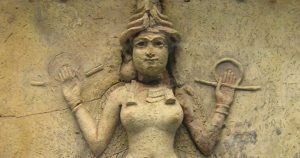As we noted in our previous article, shattering God’s boundaries for gender was a key element of her cult.
At Inanna’s festivals men dressed as women and women dressed as men, and cultic dancers wore outfits that were men’s clothes on the right and women’s on the left. Some, though not all of, Inanna’s priests practiced same-sex behavior.… Therefore, some of Inanna’s earliest temple personnel displayed same-sex behavior and took on transgender, non-heteronormative identities.[1]
By emulating their goddess who was both female and male, they shattered the boundary between the sexes.… The cultic personnel of the goddess in their costumes, words, and acts had but one goal: “to delight Ishtar’s heart, give themselves up to (otherwise) for[bidden] actions.”[2]

We could go deeper into this discussion, but only at the risk of getting more graphic than necessary to make the point.[3] We can summarize by describing the so-called goddess of love as an androgynous deity of carnal perversion whose followers included cross-dressers, transgenders, homosexuals, and prostitutes.
Worship of Inanna extended well into the biblical era. As the Canaanite goddess Astarte, her cult was spread throughout the Holy Land by the pagan neighbors of Israel. Texts from Ugarit reveal that she was venerated as both female and male—as Astarte, represented by Venus as the evening star, and as the war-god Attar, who was Venus as the morning star. All too often, the veneration of Astarte was practiced by the Israelites themselves.
Judah, patriarch of the tribe that produced the Messiah, Jesus, had relations with his daughter-in-law, Tamar, while she was dressed up as a cult prostitute, probably for Astarte (see Genesis 38). More than a thousand years later, around 623 BC, King Josiah of Judah “broke down the houses of the male cult prostitutes who were in the house of the Lord.”[4]
Think about that: Male cult prostitutes had houses inside the Temple! This was less than a century after the kingdom of Judah had been cleaned up by the good King Hezekiah, who followed the Law so closely that “there was none like him among all the kings of Judah after him, nor among those who were before him.”[5] This shocking desecration of the Temple is another reminder that the supernatural war is all about control of Zion, God’s mount of assembly.
But really, it’s not terribly surprising that Inanna/Ishtar/Astarte has had such a long career. It’s easy to sell humans on the idea that sex is worship.
With all due respect to the learned scholars who have described this entity as “a complex, multifaceted goddess,”[6] the character of Inanna/Ishtar isn’t as complicated as she’s made out to be. Frankly, she’s a bad screenwriter’s idea of a fifteen-year-old boy’s fantasy, interested mainly in sex and fighting and better than men at both. She was selfish and violent, ruled by her passions, and incredibly destructive when she didn’t get her way.
One of the tales of the Sumerian hero Gilgamesh, who ruled Uruk two generations after Enmerkar (Nimrod), is about his rejection of Ishtar’s sexual advances. In the legend, Gilgamesh had the bad manners to point out that every one of the men in the goddess’ life had suffered horrible consequences. Take, for example, Dumuzi the Shepherd, king of Bad-Tibara, the second city in Sumer to exercise kingship after Eridu. Even though Ishtar married Dumuzi, she threw him under the bus without hesitation when demons tried to drag her son, Lulal, the patron god of Bad-Tibara, down to the netherworld.
At Ishtar’s urging, the demons spared Lulal and took Dumuzi instead. When Dumuzi’s grief-stricken sister pleaded for his return, Inanna allowed her to take his place for half the year, thus making Dumuzi the first of many “dying and rising gods” in the ancient Near East. (Remember Ezekiel’s description of women weeping for Tammuz—Dumuzi—at the north gate of the Temple.)[7]
Well, for daring to remind the goddess about the sad fate of Dumuzi and the other poor idiots who’d succumbed to her charms, she flew up to heaven in a rage and demanded that her grandfather, the sky-god Anu, unleash the Bull of Heaven on Gilgamesh.
That didn’t go well for the Bull of Heaven. Although the monstrous bovid tore up Uruk, killing hundreds of people who got in its way, Gilgamesh and his buddy, Enkidu, killed the beast. When Ishtar angrily descended to the walls of the city to curse Gilgamesh, Enkidu mocked the goddess by tearing off the bull’s thigh and throwing it in her face. Sadly for Gilgamesh, however, Enkidu was sentenced to death by the gods as punishment for spoiling Ishtar’s revenge.
Now, bear in mind that, according to Enmerkar and the Lord of Aratta, this was who Nimrod wanted to make the patron goddess of his city, Uruk. That says something about the character of Nimrod, who was apparently no stranger to violence. He was the first who tried to build a world empire, evidently by force. That leads to the other aspect of the goddess that we need to explore—her violent side. She was not only the goddess of carnal pleasure, she was a war goddess, too.
Her role in the ancient Near East included that of the heroic warrior. She was often depicted in the art of ancient Sumer with multiple weapons strapped to her back,[8] and the field of battle was described as the “playground of Ishtar.”[9] She was also the deity who controlled the masculinity of kings on the battlefield. By rendering rulers impotent, as it were, she directed the outcome of war.[10]
Looking at the values of our modern society, it’s no stretch to say that Inanna is the spirit of our age. Gender fluidity is the flavor of the month among Western progressives. The values of Inanna/Ishtar—immediate gratification and sex with whomever, whenever—are considered more open-minded, tolerant, and loving than the virtues of chastity, fidelity, and faithfulness introduced by Yahweh long after Inanna was first worshiped as the Queen of Heaven.
As we’ll see, however, the perverse sexual aspects of the goddess have been combined with her mindless rage and bloody violence in a religious system that’s been trying to conquer the world for the last fourteen hundred years.
[1] Christopher E. Ortega, “Inanna: Reinforcer of Heteronormativity, or Legitimizer of Non-Heteronormativity?” Paper presented at the Spring 2015 Western Regional Conference of The American Academy of Religion (Long Beach: California State University, 2015), 2–3.
[2] Rivkah Harris, “Inanna-Ishtar as Paradox and a Coincidence of Opposites.” History of Religions, Vol. 30, No. 3 (Feb. 1991), 277.
[3] For example, Ortega (cited above) points out that some of Inanna’s temple personnel were cross-dressing priests called gala. The Sumerian word gala was formed by the symbols for “penis” and “anus.”
[4] 2 Kings 23:7 (ESV).
[5] 2 Kings 18:5 (ESV).
[6] Harris, op. cit., 261.
[7] Ezekiel 8:14.
[8] Akio Tsukimoto, “‘In the Shadow of Thy Wings’: A Review of the Winged Goddess in Ancient Near Eastern Iconography.” In David T. Sugimoto (Ed.), Transformation of a Goddess: Ishtar – Astarte – Aphrodite (Fribourg: Academic Press; Göttingen: Vandenhoeck & Ruprecht, 2014), 15–16.
[9] Matsushima, op. cit., 3.
[10] Ilona Zsolnay, “Ištar, ‘Goddess of War, Pacifier of Kings: An Analysis of Ištar’s Martial Role in the Maledictory Sections of the Assyrian Royal Inscriptions.” Sumerian and Akkadian Literature and Literary Language(Winona Lake, In.: Eisenbrauns, 2010), 402.


Another great teaching article, you had me scurrying back and forth from the Bible to the article…thankyou for sharing your knowledge to all of us. I love you guys and appreciate your commitment to our Lord.